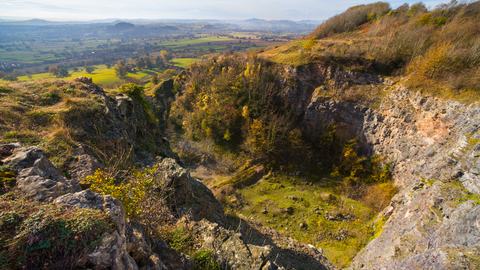
Shropshire and Beyond
Know before you go
Dogs
Grazing animals present some of the year.
When to visit
Opening times
Open at all timesBest time to visit
April to AugustAbout the reserve
From the Welshpool direction, the dramatic cliff face of the quarry confronts you miles before you get to Llanymynech, rising suddenly from the low-lying, flat fields around the Morda and Vyrnwy rivers. The hills here mark the beginning of the Oswestry uplands, a limestone outcrop that continues up into north-east Wales.
Mining and quarrying on a small scale were carried out here for more than 2000 years, right up until the First World War. Reminders of this ancient industry can be seen in the old stone tramways and a winding house. The old quarries were designated a nature reserve in 1972 and much of it has regenerated as woodland; ash trees twined in wild clematis, or old man’s beard, as it is also known, on account of the smoky wreathes of seed-heads that turn bushes and trees white here in autumn.
But the greatest botanical treasures are found in the short grassland and old spoil heaps directly beneath the cliff. Bee and pyramidal orchids grow here, along with the bright yellow rock rose and a whole herb garden of aromatic herbs – thyme, marjoram and wild basil. Wild clematis becomes a problem here; only the determined efforts of the Trust’s volunteers and a small flock of Hebridean sheep prevent it smothering the flower-rich swards.
New glades are being opened up and small-scale felling carried out to open up a corridor of light for butterflies. Pearl-bordered fritillaries, re-introduced on the Welsh side of the reserve have been seen on the Shropshire side. These butterflies need sunlight and violets, food plant of their caterpillars.
Contact us
Location map
Become a member and support our work
The vital work we do for nature depends on the support of people who care about the future of Shropshire's wildlife and wild places.




